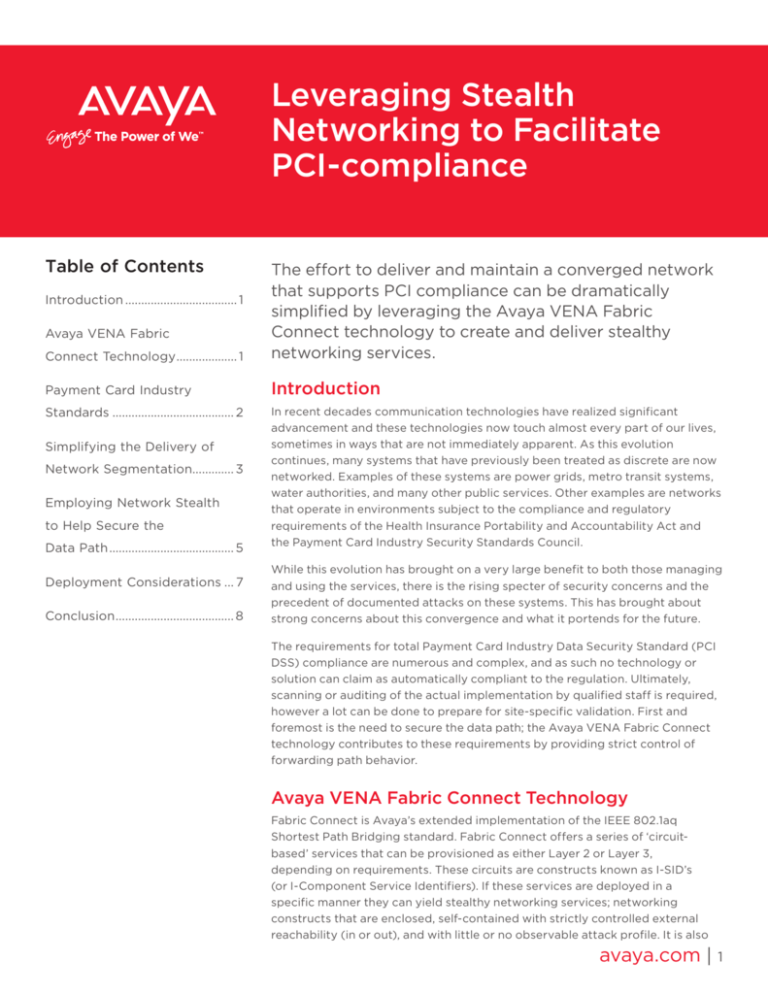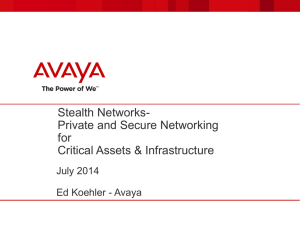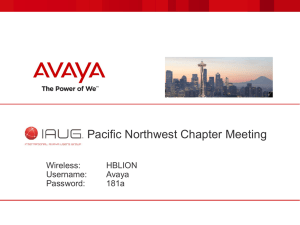
Leveraging Stealth
Networking to Facilitate
PCI-compliance
Table of Contents
Connect Technology.................... 1
The effort to deliver and maintain a converged network
that supports PCI compliance can be dramatically
simplified by leveraging the Avaya VENA Fabric
Connect technology to create and deliver stealthy
networking services.
Payment Card Industry
Introduction
Standards....................................... 2
In recent decades communication technologies have realized significant
advancement and these technologies now touch almost every part of our lives,
sometimes in ways that are not immediately apparent. As this evolution
continues, many systems that have previously been treated as discrete are now
networked. Examples of these systems are power grids, metro transit systems,
water authorities, and many other public services. Other examples are networks
that operate in environments subject to the compliance and regulatory
requirements of the Health Insurance Portability and Accountability Act and
the Payment Card Industry Security Standards Council.
Introduction.................................... 1
Avaya VENA Fabric
Simplifying the Delivery of
Network Segmentation............. 3
Employing Network Stealth
to Help Secure the
Data Path........................................ 5
Deployment Considerations.... 7
Conclusion...................................... 8
While this evolution has brought on a very large benefit to both those managing
and using the services, there is the rising specter of security concerns and the
precedent of documented attacks on these systems. This has brought about
strong concerns about this convergence and what it portends for the future.
The requirements for total Payment Card Industry Data Security Standard (PCI
DSS) compliance are numerous and complex, and as such no technology or
solution can claim as automatically compliant to the regulation. Ultimately,
scanning or auditing of the actual implementation by qualified staff is required,
however a lot can be done to prepare for site-specific validation. First and
foremost is the need to secure the data path; the Avaya VENA Fabric Connect
technology contributes to these requirements by providing strict control of
forwarding path behavior.
Avaya VENA Fabric Connect Technology
Fabric Connect is Avaya’s extended implementation of the IEEE 802.1aq
Shortest Path Bridging standard. Fabric Connect offers a series of ‘circuitbased’ services that can be provisioned as either Layer 2 or Layer 3,
depending on requirements. These circuits are constructs known as I-SID’s
(or I-Component Service Identifiers). If these services are deployed in a
specific manner they can yield stealthy networking services; networking
constructs that are enclosed, self-contained with strictly controlled external
reachability (in or out), and with little or no observable attack profile. It is also
avaya.com | 1
Avaya’s Fabric Connect
provides for fast and
nimble private
networking circuit
based capabilities that
are unparalleled in the
industry and do not
require complex mixes
of protocols or design
practices.
highly desirable that these constructs be mutable in both services and coverage
characteristics. The comparable terms in conventional networking are MPLS
IP-VPN, Routed Black Hole Networks, and IP VPN Lite.
Avaya’s Fabric Connect provides for fast and nimble private networking circuit
based capabilities that are unparalleled in the industry and do not require
complex mixes of protocols or design practices. Hence, stealth networks are
private (‘dark’) networks that are provided as standalone services within the
Fabric Connect cloud. They come in two different forms:
•Layer 2 non-IP Virtual Service Network
•Layer 3 IP Virtual Service Network
There are many uses for stealth networks, but they basically fall into two
category types. The first being for networks that require security and isolation,
and examples are PCI & Health Insurance Portability and Accountability Act
(HIPAA) compliance, financial and trading applications, video surveillance and
process flow control environments such as those facilitated by SCADA
(Supervisory Control And Data Acquisition) type protocols. The second
category is networks that require services separation such as Multicast,
Bonjour, and again for SCADA-based applications.
Stealth networks help provide for both requirements categories. While this
document is focused on PCI DSS, these services can also be applied to other
closed, service-separated networking requirements such as those for HIPAA
and CIP/NERC (Energy Regulatory).
Payment Card Industry Standards
It is valid to first define the PCI standards of PCI DSS and PA-DSS. PA-DSS, the
‘Payment Application – Data Security Standard’, is the security standard that
specifically addresses the application, as such it is a subset of PCI DSS, the
‘Payment Card Industry Data Security Standard’. An important aspect of PA
DSS is that it defines what a ‘compliant’ application must, by design, support.
Areas of concern are the handling of magnetic stripe data, card verification
codes and personal identification numbers (PINs). If a point of sale application
is sold ‘off the shelf’ it must comply with this certification. Where developed
in-house, it is the responsibility of the merchant or service provider to properly
design and certify the application.
In contrast, PCI DSS deals with the broad end-to-end implementation as
deployed. As such, the end-to-end system must be ‘scanned’ by properly
trained and certified consultants to gain compliance. This is an important
consideration because if the deployment is not properly thought-out,
compliance can become a moving target where any changes to the deployment
can put compliance a risk. Fortunately, there is an approach referred to as
‘sampling’ and the use of deployment templates that can dramatically ease
both the attainment and on-going maintenance of compliance. Fabric Connect
and the use of secure circuit-based services can drastically ease the burden of
developing and enforcing a template PCI DSS design.
avaya.com | 2
In the context of PCI, the major focus for Fabric Connect is in the areas of
service and path separation and control; this is enabled by its next generationnetwork segmentation abilities. According to PCI DSS, while network
segmentation is not explicitly required for compliance, its use is strongly
recommended. Network segmentation can provide an effective foundation for
sampling and templates. As such, its use can reduce the scope of the initial
assessment and as a result its overall cost. Additionally, it can provide for
significant reduction in the cost of ongoing maintenance of the environment.
But this is only if the network segmentation is properly designed, implemented,
and secure.
Proper design can lead to modularity and the ability to maintain consistency
between modules. The end result is the ability to streamline compliance by the
use of these templates and sampling.
Simplifying the Delivery of Network Segmentation
Avaya’s Fabric Connect technology, based on an extended implementation of
the IEEE’s 802.1aq Shortest Path Bridging standard, can be deployed in concert
with an access control broker element known as Identity Engines. When used in
tandem with Fabric Connect, Identity Engines becomes a very powerful PCI
enforcement tool that can address the topic of network segmentation as it is
addressed in ‘Appendix D’ for PCI DSS compliance. A high level overview of the
twelve requirements is provided as follows:
Fabric Connect and Identity Engines (IDE) can be used to provide an
enforcement paradigm for the PCI DSS network service paths for a number
of these requirements; namely 3, 5, 7, 8, and 10. The solutions use also
compliments and simplifies PCI audit requirements.
There is a concept known as ‘composite identities’ and, in cyber-space all
identities are essential thus. This basic concept is rather obvious when it speaks
to elemental constructs of device/user combinations, but it gets smeared and
somewhat fuzzy when the concept extends to applications or services.
Alternatively it can extend to elements such as location or systems that a user is
avaya.com | 3
All are elements of a
composite instance of
a user and they are
contained within a
space/time context…
we may allow ‘User A’
for access Application
A’ from ‘Location A’
with ‘Device A’…but
any other combination
may provide a
totally different
authentication and
consequent access
authorization response.
logged into. All are elements of a composite instance of a user and they are
contained within a space/time context. As an example, we may allow ‘User A’
for access ‘Application A’ from ‘Location A’ with ‘Device A’. But any other
location, device or even time combination may provide a totally different
authentication and consequent access authorization response, up to and
including complete denial of service.
This composite approach is very powerful, and particularly so when combined
with the rather strong path control capabilities of Fabric Connect. This
combination yields an ability to determine network placement, both expected
and within profile, but more importantly for those that are unusual and out of
the normal users profile. These instances may require additional challenges and
consequent authentications.
This concept can be visualized as a series of gates. The first gate provides
identification of a particular user/device combination. From this elemental
composite, network access is provided according to a policy, and users are
limited to the particular paths that provide access to a normal profile. As a user
attempts to access a secure application the network responds with an
additional challenge. This may be an additional password or perhaps a certain
secure token and biometric signature to reassure identity for the added degree
of trust. This is all normal, ‘steady-state’ behavior. However in this scenario,
access is provided at the systems level, thereby increasing the ‘smear’ of the
user’s identity.
A critical distinction for the approach under discussion is that the network
placement profile of the user changes. In other words, in the previous network
profile the system that provides the secure application is not even available by
any viable network path. It is by the renewal of challenge and additional tiers of
authentication that connectivity is finally granted. It should be noted that we
are discussing access as opposed to connectivity. Systems access controls
would of course remain, but, by and large, these would be the final gates
involved. At the user edge, entire logical topology changes occur that place the
user into a Fabric-based, stealth virtual private network environment where
more secure, segregated access to the sensitive application can then be
obtained.
Taking a moment to discuss the anatomy of circuit-based services, a Layer 2
stealth network is simplicity itself, being an I-SID associated with a specific
VLAN; in this case the VLAN is not configured with an IP Address. As such, a
standalone Layer 2 network is created where no traffic can enter or exit, and
these are extremely useful to help secure and extend Layer 2 environments
(such as those delivering SCADA services). Layer 2 stealth networks allow for a
pain-free and more secure distribution of such environments. Additionally, IP
can operate inside this style of network, but it is a self-contained IP subnet and
not one routed to the outside world; it is, in essence, invisible. As a result they
can be leveraged for more secure Data Center usage where it may be
undesirable to enable IP reachability. As a comparison, the equivalent service in
MPLS, known as Layer 2 VPLS, requires approximately thirty to forty unique
lines of configuration whereas a Fabric Connect Layer 2 stealth network is
typically created with a single command.
avaya.com | 4
The anatomy of a Layer stealth networking is correspondingly simple. It is
nothing more than an I-SID, essentially an SPB ‘circuit’, associated with a Virtual
Routing and Forwarding (VRF) instance. The VLANs attached to the VRF are
assigned IP Addresses, however none of the IP subnets are reachable outside of
the IP VPN environment. As such, a standalone Layer 3 IP network is created
where nothing can enter or exit. It is, in essence, invisible to the outside world.
This scenario is useful for a variety of Layer 3 environments with enhanced
security, such as PCI DSS networks, but is also useful in providing service
separation in possible conflicting protocol environments such as the case of
multiple multicast domains.
Employing Network Stealth to Help Secure the
Data Path
Fabric-based services can be used in combination to yield genuinely closed and
segregated network topologies. A Layer 3 VSN can be used to extend network
PCI compliance support to distant point-of-sale applications. These PA-DSS
application end-systems will gain access to the network via authentication
provided by the Identity Engines technology. The L3 VSN might then extend to
the Data Center security demarcation point where there is a single port at the
perimeter’s Firewall/IDS boundary. On the other side of the demarcation, L2
VSNs provide for secure connectivity to Data Center services. The complete
end-to-end design yields a closed network systems environment that is isolated
from the outside world.
This model delivers something significant. Users are now assigned to
‘communities of interest’ where only certain traffic pattern profiles are
expected. As a result, IPS/IDS alerts generated as a result of new anomalies are
something more than white noise; they become discrete events set against a
backdrop of the expected monitoring profile. Anomalies outside of that profile
will correctly flag as a ‘positive’ alert that should be investigated. This enables
‘Day Zero’ threat systems to work far more efficiently, complementing the very
logic of their theory of operation, that being to look for patterns outside of the
expected behaviors that are normally seen in the network. Fabric Connect ’s
role is in keeping communities strictly separated. With a smaller isolated
community it is far easier to use such systems accurately, defining a discrete
and easily manageable virtualized security perimeter. It should be noted that
any end-point is logically on the ‘outer’ network. Even though different VSNs
traverse a common network footprint they are ‘ships in the night’; they never
see one another or have the opportunity to inter-communicate unless
specifically configured as an exception, through formal monitored gateways.
Firewalls are notoriously complex when they are used for community separation
or multi-tenant applications. The reason for this is that the separation capability
is dependent on the security policy database (SPD) and how well it covers all
given applications and port calls. If a new application is introduced and needs
to be isolated, the SPD must be modified to reflect it. If this evolution gets
overlooked or the settings are not correct, the application is not isolated and
the network’s entire security posture may be compromised. This is the major
flaw in the logic of explicit administration. Again Fabric Connect’s network
virtualization helps in controlling user’s paths and keeping communities
avaya.com | 5
Networks that require
full privacy in order
to support PCI
compliance are
those where Fabric
Connect’s stealth
networking capability
is particularly useful…
when properly
designed, should pass
PCI compliancy
scanning and analysis.
separate. Now the Firewall’s security policy database can be ‘white listed’ with
a ‘black list’ policy that then denies all. Now as new applications get installed,
and unless they are specifically added to the white list, they will, by default,
be isolated to the community that they reside in. This results in far less
manipulation of individual security databases in addition to a significantly
reducing the risk of an attack surface developing in the security perimeter
simply as the result of a missed policy statement.
Networks that require full privacy in order to support PCI compliance are those
where Fabric Connect’s stealth networking capability is particularly useful; L3
Virtual Service Networks are perfect for these solution requirements. A ready
example might be that of a PCI environment in which all subsystems are within a
totally closed L3 VSN virtual private network. Ingress and egress is only
available via well-defined virtual security perimeters that allow for the full
monitoring of any and all allowed traffic. This combination yields an
environment that, when properly designed, should pass PCI compliancy
scanning and analysis. In addition, these networks not only are private, but they
are invisible to external, would-be attackers. The attack surface is mitigated to
the virtual security parameter only, and as such it is practically non-existent.
As previously noted, the use of sampling can greatly reduce the cost and
complexity of attaining and maintaining compliance. The practice does
however require discipline in both the modularity and consistency of the design
and implementation. Modules can be based upon well-defined templates and
subsequently re-produced, but this must be done exactly as defined within the
approved template. Variations will result in the need for re-scanning and
caution must be exercised, as small, seemingly inconsequential divergence
from the templates can result in the need to scan. For example, where a new
operating system is used in a remote point-of-sale location, or in a Data Center
where a particular data repository is migrated to a different Storage Area
Network (SAN) technology. However, where properly implemented, sampling
and templates can drastically reduce the overall compliance and on-going
maintenance costs.
As defined in ‘Appendix D’ of the PCI DSS documentation, if the requirements
for network segmentation are both realized and validated then the entire
process moves on to the sampling of business facilities, system components,
and practices. Avaya’s Fabric Connect technology can address all network
segmentation requirements without the need for undue complexity such as
that observed with technologies such as MPLS.
Dictating module demarcation points and implementing modules exactly as
defined within the templates enables compliancy to be streamlined. As an
example, for remote point-of-sale locations, a series of templates can be
created, such as small, medium and large, and these templates could cover
typical hardware, network topologies and configurations. Adhering to these
templates means that during compliance scanning only one representative of
each type needs to be validated, being equivalent for all like templates.
Therefore, an organization dealing with a large number of point-of-sales
locations can significantly reduce the overall cost and difficulty of attaining
and maintaining compliance.
avaya.com | 6
Deployment Considerations
From Avaya’s Fabric Connect perspective it’s all about services separation
and path control; or ‘network segmentation’ in PCI DSS parlance. No other
networking technology provides a more comprehensive set of services, and
with so little complexity. The PCI DSS compliance checklist will run along the
lines of:
•Be sure to terminate L3 VSNs as close to the edge as possible
– Avoid using shared broadcast domains or VLAN extensions via tagged trunks, and if VLAN extensions are required, use L2 VSNs to maintain total separation
•Limit port memberships into the security demarcation only to those required.
– Ideally this should be a single port membership to prevent unauthorized system access to the DMZ.
•Limit port memberships to PA-DSS end-points only
– Identity Engines can greatly ease the enforcement of these access policies.
•Avoid mixing any non PA-DSS applications in the PCI DSS stealth network
topology even if they do not access anything on the outside
– Such mixing can result in the violation of templates and hence require full site scanning
•Validate the security demarcation module and create a defined security policy
database and network topology template
– Be sure to do testing of the demarcation to be sure that the policy database is enforced
•Avoid the use of the public Internet or wireless services within the end-to-end
design.
–
When this avoidance is impractical, use encryption to protect transit data; MACsec encryption can be used to protect exposed Ethernet trunks and full VPN encryption (using either IPSec or SSL) can be used to provide end-
point or site connectivity. Be sure to have the VPN Gateways attached directly to the stealth network topology to help ensure that no unencrypted data paths are exposed.
Private IP VPN environments have been around for many years, yet they
typically remain clumsy and complex to provision, and this is particularly true
for environments where quick dynamic changes are required. As an example,
the typical MPLS IP VPN provisioning activity will require approximately 200
to 250 lines of configuration, depending on the vendor and the topology.
Ironically, much of this error-prone configuration activity is not directly related
to provisioning the VPN, but in provisioning underlying protocols such as
gateway routing protocols. And remember that this is just to provide the
primary service path, with redundant service paths needing further manual
configuration. By comparison, Avaya’s Fabric Connect technology provides the
avaya.com | 7
same service type with as few as a dozen commands, and there is no
requirement to engineer and provision resilient service paths as this is natively
provided for by SPB’s intelligence.
As a result, Fabric Connect-based VPNs can be provisioned in minutes, and
dynamically moved or extended to satisfy a variety of business requirements.
For example, the evolution of emergency telephony services (E911) speaks to
how an L3 VSN IP VPN can morph over the duration of a short-term emergency,
with different agencies and individuals coming into and out of the VPN
environment on a dynamic basis due to their identity, role, and group
associations.
Furthermore, Fabric Connect-enabled nodes are themselves mutable; meaning
that they may be liable to and easily capable of change; SPB’s IS-IS delivers
this capability. An active Fabric Connect node can be detached from the
topology, relocated, and reconnect at any point and the underlying protocol
will immediately re-establish full topology connectivity, with provisioned
services again available. The Fabric Connect network will extend all services
to the node, thereby delivering complete portability to that node and its
resident services and users.
In addition, Fabric Connect can provide separation for non-IP data
environments where mission-specific applications can enjoy an isolated, non-IP
environment by the use of L2 VSNs and further, they can be isolated to mitigate
any risk of would-be hackers gaining a viable path into the environment.
Conclusion
It’s the combination of segmentation and mutability that enables Fabric
Connect to deliver highly effective stealth networking services. Presenting
virtually no observability these networking constructs cannot be seen and
therefore they mitigate the risk of attack, lacking the ‘profile’ for such an
endeavor. They are agile in the way they can morph through the use of services
extensions. Other IP VPN technologies would be very hard pressed to make
such claims, if indeed they can make them at all, and certainly not with
operational simplicity unique to Fabric Connect.
The Avaya VENA Fabric Connect technology, based as it is on the IEEE 802.1aq
Shortest Path Bridging technology, sets the foundation for genuine private
cloud networking, allowing for the versatile creation and deployment of stealth
networking services, and as such facilitates the acquisition and retention of PCI
DSS compliance.
avaya.com | 8
About Avaya
Avaya is a leading, global provider of customer and team engagement solutions and
services available in a variety of flexible on-premise and cloud deployment options.
Avaya’s fabric-based networking solutions help simplify and accelerate the deployment
of business critical applications and services. For more information, please visit
www.avaya.com.
© 2015 Avaya Inc. All Rights Reserved.
Avaya and the Avaya logo are trademarks of Avaya Inc. and are registered in the United States and other countries.
All other trademarks identified by ®, TM, or SM are registered marks, trademarks, and service marks, respectively,
of Avaya Inc.
04/15 • DN7448-01
avaya.com | 9








